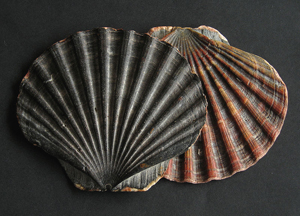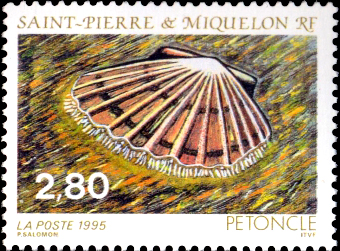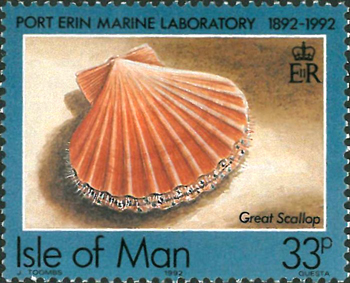Pecten maximus Linnaeus, 1758

(Da: www.en.wikipedia.org)
Phylum: Mollusca Cuvier, 1797
Classe: Bivalvia Linnaeus, 1758
Ordine: Pectinida Adams & Adams, 1857
Famiglia: Pectinidae Rafinesque, 1815
Genere: Pecten Müller, 1776
Italiano: Cappasanta atlantica
English: Great scallop, King scallop, St James shell, Escallop
Français: Coquille Saint-Jacques
Deutsch: Große Pilgermuschel
Español: Vieira
Descrizione
Ha valve difformi, la superiore è completamente piatta e provvista di coste. È di un colore che va dal rosso al bruno, talvolta rosa o chiazzato. La cappasanta atlantica possiede particolarità, rara nel mondo animale dei molluschi, è infatti munita di circa 200 occhi catadiottrici elementari (specie di specchi formati da strati di cristalli cubici di guanine che funzionano per riflessione) situate sul bordo della sua conchiglia. Gli occhi sono visibili sotto la forma di punti neri brillanti sul bordo del mantello di una conchiglia di cappasanta semiaperta. La cappasanta atlantica è ermafrodita. La sua ghiandola genitale, detta corallo in gastronomia, è costituita da due parti: una maschile, color bianco avorio (da non confondere con il piede); l'altra femminile, rosso arancio. Queste due parti non arrivano a maturità insieme, poiché i gameti maschili precedono generalmente quelli femminili (protandria). La cappasanta atlantica può spostarsi relativamente veloce su corte distanze, per salti, schioccando le sue valve ed espellendo rapidamente l'acqua (idropropulsione). Allo stato libero, essa può vivere una ventina d'anni. Alla sua taglia commerciale pesa circa 190 gr di cui 120 di conchiglia. Oltre ad Asterias rubens e Astropecten irregis i principali predatori di Pecten maximus sono i granchi come Cancer pagurus, Carcinus maenas, Liocarcinus puber e Liocarcinus depurator che predano le capesante man mano che crescono.
Diffusione
Si trova nell'Atlantico orientale lungo la costa europea dalla Norvegia settentrionale, a sud fino alla penisola iberica, è stato segnalato anche al largo dell'Africa occidentale, al largo delle isole della Macaronesia. In Gran Bretagna e Irlanda è distribuito su tutto il litorale ma è raro e localizzato sulla costa orientale del Mare del Nord. Preferisce le acque offshore fino a 100 m di profondità.
Sinonimi
= Ostrea maxima Linnaeus, 1758 = Pecten medius Daniel, 1883 = Pecten vulgaris da Costa, 1778 = Plicatula similis G. B. Sowerby II, 1842.
Bibliografia
–"Pecten maximus (Linnaeus, 1758)". World Registry of Marine Species. Retrieved 1 January 2017.
–Latchford, John W.; Beaumont, Andy R.; Wilding, Craig S. (October 1999). "Are Pecten maximus and Pecten jacobaeus different species?". Journal of the Marine Biological Association of the United Kingdom. 79 (5): 949-952.
–"Pecten maximus (Linnaeus, 1758)". Food and Agriculture Organization of the United Nations Department of Fisheries and Aquaculture. Retrieved 1 January 2017.
–"Mollusca of the North Sea M.J. de Kluijver, S.S. Ingalsuo & R.H. de Bruyne Pecten maximus". Marine Species Identification Portal. ETI BioInformatics. Retrieved 1 January 2017.
–"BIOTIC Species Information for Pecten maximus". BIOTIC (Biological Traits Information Catalogue). MarLIN (Marine Life Information Network). Retrieved 1 January 2016.
–A. Beaumont; T. Gjedrem (2007). Scallops - Pecten maximus and P. jacobaeus (Report). Genimpact. Retrieved 1 January 2017.
–Bryce D. Beukers-Stewart; Joanne S. Beukers-Stewart (2009). Principles for the Management of Inshore Scallop Fisheries around the UK (PDF) (Report). University of York. Retrieved 1 January 2016.
–N. C. H. Lake; M. B. Jones; J. D. Paul (1987). "Crab predation on scallop (Pecten maximus) and its implication for scallop cultivation (abstract)". Journal of the Marine Biological Association of the United Kingdom. 67 (1): 55-64.
–Dan Minchin (1982). "Predation on young Pecten maximus (L.) (Bivalvia), by the anemone Anthopleura ballii(Cocks) (abstract)". Journal of Molluscan Studies. 49 (3): 228-231.
–C Lambert; JL Nicolas; V Cilia; S Corre (1998). "Vibrio pectenicida sp. nov., a pathogen of scallop (Pecten maximus) larvae. (abstract)". International Journal of Systematic Bacteriology. 48 Pt2 (2): 481-487.
–Lise Thorkildsen; Christophe Lambert; Are Nylund; Thorolf Magnesen; Øivind Bergh (2005). "Bacteria associated with early life stages of the great scallop, Pecten maximus: impact on larval survival (abstract)". Aquaculture International. 13 (= 6): 575-592.
–R.P. Briggs (2000). "The great scallop: an endangered species". Biologist. 47 (5): 260-264.
–Nicole Devauchelle; Christian Mingant (1991). "Review of the reproductive physiology of the scallop, Pecten maximus, applicable to intensive aquaculture" (PDF). Aquatic Living Resources. 2: 41-51.
–Øivind Bergh; Øivind Strand (2001). "Great scallop, Pecten maximus, research and culture strategies in Norway: a review (abstract)". Aquaculture International. 9 (4): 305-317.
–"Great scallop". Ecomare. Retrieved 1 January 2016.

|
Data: 10/07/1995
Emissione: Fauna marina Stato: St. Pierre and Miquelon Nota: Emesso in una striscia di 4 v. diversi |
|---|

|
Data: 16/04/1992
Emissione: Laboratorio Marino Port Erine 1892-1992 Stato: Isle of Man Nota: Emesso in una serie di 5 v. diversi |
|---|

|
Data: 31/07/2014
Emissione: Animali irlandesi e vita marina Stato: Ireland |
|---|